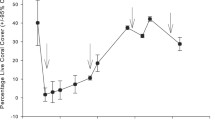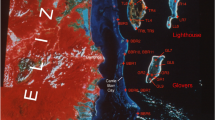Abstract
Coral reefs globally are threatened by climate change, but reef assemblages at high latitudes may serve as refugia. Marginal coral communities located in the subtropical Southwestern Atlantic are poorly studied, but were subject to an unprecedented heatwave and associated coral bleaching in 2019. Record values of 18.5 and 20.5 °C-weeks were registered for coastal and insular sites, which are the highest ever documented for a reef in the South Atlantic. As a consequence, approximately 80% and 20% of the population of the reef-building coral Mussismilia hispida (1116 colonies surveyed) underwent bleaching in coastal and insular sites, respectively. However, mortality (2%) was far lower than for episodes of similar magnitude in other regions, particularly in the Indo-Pacific. Therefore, the subtropical Southwestern Atlantic MCC displayed low mortality and remarkable tolerance when exposed to the most intense bleaching episode ever recorded for the region, reinforcing its potential as a refugium.




Similar content being viewed by others
References
Beger M, Sommer B, Harrison PL, Smith SDA, Pandolfi JM (2014) Conserving potential coral reef refuges at high latitudes. Divers Distrib 20:245–257
Bennett S, Vergés A, Bellwood DR (2010) Branching coral as a macroalgal refuge in a marginal coral reef system. Coral Reefs 29:471–480
Berkelmans R, Oliver JK (1998) Large-scale bleaching of corals on the Great Barrier Reef. Coral Reefs 18:55–60
Cacciapaglia C, van Woesik R (2016) Climate-change refugia: Shading reef corals by turbidity. Glob Chang Biol 22:1145–1154
Castro CB, Pires DO, Medeiros MS, Loiola LL, Arantes RCM, Thiago CM, Berman E (2006) Filo Cnidaria. In: Lavrado HP, Ignacio BL (eds) Biodiversidade bentônica da região central da Zona Econômica Exclusiva brasileira. Museu Nacional, Rio de Janeiro, pp 147–192
CPTEC/INPE (2019) Temperaturas permanecerão elevadas. https://www.cptec.inpe.br/noticias/noticia/130280. Accessed 1 April 2019
De’ath G, Fabricius KE, Sweatman H, Puotinen M (2012) The 27-year decline of coral cover on the Great Barrier Reef and its causes. Proc Natl Acad Sci 109:17995–17999
Eakin CM, Morgan JA, Heron SF, Smith TB, Liu G, Alvarez-Filip L, Baca B, Bartels E, Bastidas C, Bouchon C et al (2010) Caribbean corals in crisis: Record thermal stress, bleaching, and mortality in 2005. PLoS ONE 5:e13969
Ennis RS, Brandt ME, Wilson Grimes KR, Smith TB (2016) Coral reef health response to chronic and acute changes in water quality in St. Thomas, United States Virgin Islands. Mar Pollut Bull 111:418–427
Falter JL, Zhang Z, Lowe RJ, McGregor F, Keesing J, McCulloch MT (2014) Assessing the drivers of spatial variation in thermal forcing across a nearshore reef system and implications for coral bleaching. Limnol Oceanogr 59:1241–1255
Francini-Filho RB, Asp NE, Siegle E, Hocevar J, Lowyck K, D’Avila N, Vasconcelos AA, Baitelo R, Rezende CE, Omachi CY et al (2018) Perspectives on the Great Amazon Reef: extension, biodiversity, and threats. Front Mar Sci 5:142
Francini-Filho RB, Moura RL, Thompson FL, Reis RM, Kaufman L, Kikuchi RK, Leão ZM (2008) Diseases leading to accelerated decline of reef corals in the largest South Atlantic reef complex (Abrolhos Bank, eastern Brazil). Mar Pollut Bull 56:1008–1014
Gaeta SA, Ribeiro SMS, Metzler PM, Francos MS, Abe DS (1999) Environmental forcing on phytoplankton biomass and primary productivity of the coastal ecosystem in Ubatuba region, southern Brazil. Rev Bras Oceanogr 47:11–27
Gilmour JP, Smith LD, Heyward AJ, Baird AH, Pratchett MS (2013) Recovery of an Isolated Coral Reef System Following Severe Disturbance. Science 340:69–71
Gintert BE, Manzello DP, Enochs IC, Kolodziej G, Carlton R, Gleason ACR, Gracias N (2018) Marked annual coral bleaching resilience of an inshore patch reef in the Florida Keys: A nugget of hope, aberrance, or last man standing? Coral Reefs 37:533–547
Glynn PW (1993) Coral reef bleaching: ecological perspectives. Coral Reefs 12:1–17
Glynn PW (1996) Coral reef bleaching: facts, hypotheses and implications. Glob Chang Biol 2:495–509
Greenstein BJ, Pandolfi JM (2008) Escaping the heat: Range shifts of reef coral taxa in coastal Western Australia. Glob Chang Biol 14:513–528
Hughes TP, Anderson KD, Connolly SR, Heron SF, Kerry JT, Lough JM, Baird AH, Baum JK, Berumen ML, Bridge TC et al (2018) Spatial and temporal patterns of mass bleaching of corals in the Anthropocene. Science 359:80–83
IPCC (2013) Climate Change 2013: The Physical Science Basis. Summary for Policymakers. Cambridge University Press, Cambridge, pp 1–29
IUCN (2019) The IUCN red list of threatened species version 2019–2. www.iucnredlist.org. Accessed 1 April 2019
Kayanne H (2017) Validation of degree heating weeks as a coral bleaching index in the northwestern Pacific. Coral Reefs 36:63–70
Kiessling W (2009) Geologic and biologic controls on the evolution of Reefs. Annu Rev Ecol Evol Syst 40:173–192
Leão ZMAN, Kikuchi RKP, Testa V (2003) Corals and coral reefs of Brazil. In: Cortes J (ed) Latin American Coral Reefs. Elsevier, Amsterdam, pp 9–52
Lesser MP (2006) Oxidative stress in marine environments: biochemistry and physiological ecology. Annu Rev Physiol 68:253–278
Levitus S, Antonov J, Boyer T (2005) Warming of the world ocean, 1955–2003. Geophys Res Lett 32:1–4
Lirman D, Manzello D (2009) Patterns of resistance and resilience of the stress-tolerant coral Siderastrea radians (Pallas) to sub-optimal salinity and sediment burial. J Exp Mar Biol Ecol 369:72–77
Liu G, Strong AE, Skirving WJ, Arzayus LF (2006) Overview of NOAA coral reef watch program’s near-real-time satellite global coral bleaching monitoring activities. In: Proceedings of 10th international coral reef symposium, vol 1. pp 1783–1793
Loya Y, Sakai K, Yamazato K, Nakano Y, Sambali H, van Woesik R (2001) Coral bleaching: the winners and the losers. Ecol Lett 4:122–131
Melo Júnior M, Marcolin CR, Miyashita LK, Lopes RM (2016) Temporal changes in pelagic copepod assemblages off Ubatuba, Brazil. Mar Ecol 37:877–890
Mies M, Güth AZ, Tenório AA, Banha TNS, Waters LG, Polito PS, Taniguchi S, Bícego MC, Sumida PYG (2018) In situ shifts of predominance between autotrophic and heterotrophic feeding in the reef-building coral Mussismilia hispida: an approach using fatty acid trophic markers. Coral Reefs 37:677–689
Miranda LB, Castro BM, Rezende LF, Mello RL (2003) Variação sazonal de propriedades hidrográficas ao largo do Parque Estadual Marinho Laje de Santos (SP). Congresso Brasileiro de Pesquisas Ambientais e Saúde 1:1–4
Muniz P, Pires-Vanin AMS, Martins CC, Montone RC, Bícego MC (2006) Trace metals and organic compounds in the benthic environment of a subtropical embayment (Ubatuba Bay, Brazil). Mar Pollut Bull 52:1098–1105
NOAA Coral Reef Watch (2019) 5-km Satellite virtual station. https://coralreefwatch.noaa.gov/vs/data.php. Accessed 1 April 2019
Oliver TA, Palumbi SR (2011) Do fluctuating temperature environments elevate coral thermal tolerance? Coral Reefs 30:429–440
PacIOOS (2019) NOAA global coral bleaching monitoring products: daily 5-km. https://oos.soest.hawaii.edu/erddap/griddap/NOAA_DHW_5km.graph. Accessed 1 April 2019
Pandolfi JM, Connolly SR, Marshall DJ, Cohen AL (2011) Projecting coral reef futures under global warming and ocean acidification. Science 333:418–423
Perry CT, Larcombe P (2003) Marginal and non-reef-building coral environments. Coral Reefs 22:427–432
Riegl B (2003) Climate change and coral reefs: different effects in two high-latitude areas (Arabian Gulf, South Africa). Coral Reefs 22:433–446
Roff G, Mumby PJ (2012) Global disparity in the resilience of coral reefs. Trends Ecol Evol 27:404–413
Rogers R, Correal GO, Oliveira TC, Carvalho LL, Mazurek P, Barbosa JE, Chequer L, Domingos TF, Jandre KA, Leão LS, Moura LA, Occhioni GE, Oliveira VM, Silva ES, Cardoso AM, Costa AC, Ferreira CEL (2014) Coral health rapid assessment in marginal reef sites. Mar Biol Res 10:612–624
Schlöder C, D’Croz L (2004) Responses of massive and branching coral species to the combined effects of water temperature and nitrate enrichment. J Exp Mar Bio Ecol 313:255–268
Siebeck UE, Marshall NJ, Klüter A, Hoegh-Guldberg O (2006) Monitoring coral bleaching using a colour reference card. Coral Reefs 25:453–460
Smith-Keune C, Dove S (2008) Gene expression of a green fluorescent protein homolog as a host-specific biomarker of heat stress within a reef-building coral. Mar Biotechnol 10:166–180
Teixeira CD, Leitão RLL, Ribeiro FV, Moraes FC, Neves LM, Bastos AC, Pereira-Filho GH, Kampel M, Salomon PS, Sá JA et al (2019) Sustained mass coral bleaching (2016–2017) in Brazilian turbid-zone reefs: taxonomic, cross-shelf and habitat-related trends. Coral Reefs. https://doi.org/10.1007/s00338-019-01789-6
Valentim SS, Bernardes MEC, Dottori M, Cortezi M (2013) Low-frequency physical variations in the coastal zone of Ubatuba, northern coast of São Paulo State, Brazil. Braz J Oceanogr 61:187–193
Vargas-Ángel B, Looney EE, Vetter OJ, Coccagna EF (2011) Severe, widespread El Niño-associated coral bleaching in the US Phoenix Islands. Bull Mar Sci 87:623–638
Acknowledgements
We thank Arthur Güth for the illustrations, Gang Liu for assistance in acquisition of DHW data, and Carla Zilberberg for helping during the Alcatrazes fieldwork. MVK acknowledges the support of FAPESP (#2014/01332-0) and CNPq (#301436/2018-5). MVK, KCCC and CLBF are grateful for the support from Kelen Leite and Silvia Godoy (ICMBio).
Author information
Authors and Affiliations
Contributions
All authors designed the study; TNSB, KCCC, CLBF and MM performed fieldwork; MVK, RBFF and PYGS contributed to infrastructure/material/technical support; TNSB, KCCC, RBFF and MM analyzed the data; and all authors contributed to the manuscript.
Corresponding author
Ethics declarations
Conflict of interest
On behalf of the authors, the corresponding author states that there is no conflict of interest.
Additional information
Topic Editor John A. Burt
Publisher's Note
Springer Nature remains neutral with regard to jurisdictional claims in published maps and institutional affiliations.
Rights and permissions
About this article
Cite this article
Banha, T.N.S., Capel, K.C.C., Kitahara, M.V. et al. Low coral mortality during the most intense bleaching event ever recorded in subtropical Southwestern Atlantic reefs. Coral Reefs 39, 515–521 (2020). https://doi.org/10.1007/s00338-019-01856-y
Received:
Accepted:
Published:
Issue Date:
DOI: https://doi.org/10.1007/s00338-019-01856-y




